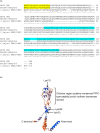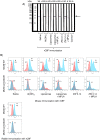Vaccine Potential and Diversity of the Putative Cell Binding Factor (CBF, NMB0345/NEIS1825) Protein of Neisseria meningitidis
- PMID: 27505005
- PMCID: PMC4978444
- DOI: 10.1371/journal.pone.0160403
Vaccine Potential and Diversity of the Putative Cell Binding Factor (CBF, NMB0345/NEIS1825) Protein of Neisseria meningitidis
Abstract
The cbf gene from Neisseria meningitidis strain MC58 encoding the putative Cell Binding Factor (CBF, NMB0345/NEIS1825) protein was cloned into the pRSETA system and a ~36-kDa recombinant (r)CBF protein expressed in Escherichia coli and purified by metal affinity chromatography. High titres of rCBF antibodies were induced in mice following immunization with rCBF-saline, rCBF-Al(OH)3, rCBF-Liposomes or rCBF-Zwittergent (Zw) 3-14 micelles, both with and without incorporated monophosphoryl lipid A (MPLA) adjuvant. Anti-rCBF sera reacted in western blots of meningococcal lysates with a single protein band of molecular mass ~29.5 kDa, indicative of mature CBF protein, but did not react with a lysate of a Δnmb0345 mutant (CBF-), demonstrating specificity of the murine immune responses. CBF protein was produced by all strains of meningococci studied thus far and the protein was present on the surface of MC58 (CBF+) bacteria, but absent on Δnmb0345 mutant (CBF-) bacteria, as judged by FACS reactivity of anti-rCBF sera. Analysis of the NEIS1825 amino acid sequences from 6644 N. meningitidis isolates with defined Alleles in the pubmlst.org/Neisseria database showed that there were 141 ST types represented and there were 136 different allelic loci encoding 49 non-redundant protein sequences. Only 6/6644 (<0.1%) of N. meningitidis isolates lacked the nmb0345 gene. Amongst serogroup B isolates worldwide, ~68% and ~20% expressed CBF encoded by Allele 1 and 18 respectively, with the proteins sharing >99% amino acid identity. Murine antisera to rCBF in Zw 3-14 micelles + MPLA induced significant serum bactericidal activity (SBA) against homologous Allele 1 and heterologous Allele 18 strains, using both baby rabbit serum complement and human serum complement (h)SBA assays, but did not kill strains expressing heterologous protein encoded by Alelle 2 or 3. Furthermore, variable bactericidal activity was induced by murine antisera against different meningococcal strains in the hSBA assay, which may correlate with variable surface exposure of CBF. Regardless, the attributes of amino acid sequence conservation and protein expression amongst different strains and the ability to induce cross-strain bactericidal antibodies indicates that rCBF could be a potential meningococcal vaccine antigen and merits further testing.
Conflict of interest statement
Figures





Similar articles
-
Immunization with recombinant truncated Neisseria meningitidis-Macrophage Infectivity Potentiator (rT-Nm-MIP) protein induces murine antibodies that are cross-reactive and bactericidal for Neisseria gonorrhoeae.Vaccine. 2018 Jun 22;36(27):3926-3936. doi: 10.1016/j.vaccine.2018.05.069. Epub 2018 May 24. Vaccine. 2018. PMID: 29803329 Free PMC article.
-
A putative amino acid ABC transporter substrate-binding protein, NMB1612, from Neisseria meningitidis, induces murine bactericidal antibodies against meningococci expressing heterologous NMB1612 proteins.Vaccine. 2015 Aug 26;33(36):4486-94. doi: 10.1016/j.vaccine.2015.07.032. Epub 2015 Jul 21. Vaccine. 2015. PMID: 26207592
-
Immunization with recombinant Chaperonin60 (Chp60) outer membrane protein induces a bactericidal antibody response against Neisseria meningitidis.Vaccine. 2013 May 24;31(22):2584-90. doi: 10.1016/j.vaccine.2013.03.033. Epub 2013 Apr 6. Vaccine. 2013. PMID: 23566947
-
Use of expanded Neisseria meningitidis serogroup B panels with the serum bactericidal antibody assay for the evaluation of meningococcal B vaccine effectiveness.Expert Rev Vaccines. 2023 Jan-Dec;22(1):738-748. doi: 10.1080/14760584.2023.2244596. Expert Rev Vaccines. 2023. PMID: 37622470 Review.
-
Serum bactericidal antibody assays - The role of complement in infection and immunity.Vaccine. 2015 Aug 26;33(36):4414-21. doi: 10.1016/j.vaccine.2015.07.019. Epub 2015 Jul 15. Vaccine. 2015. PMID: 26187262 Review.
Cited by
-
Neisseria genes required for persistence identified via in vivo screening of a transposon mutant library.PLoS Pathog. 2022 May 17;18(5):e1010497. doi: 10.1371/journal.ppat.1010497. eCollection 2022 May. PLoS Pathog. 2022. PMID: 35580146 Free PMC article.
-
Immunization with recombinant truncated Neisseria meningitidis-Macrophage Infectivity Potentiator (rT-Nm-MIP) protein induces murine antibodies that are cross-reactive and bactericidal for Neisseria gonorrhoeae.Vaccine. 2018 Jun 22;36(27):3926-3936. doi: 10.1016/j.vaccine.2018.05.069. Epub 2018 May 24. Vaccine. 2018. PMID: 29803329 Free PMC article.
-
Structure of the Recombinant Neisseria gonorrhoeae Adhesin Complex Protein (rNg-ACP) and Generation of Murine Antibodies with Bactericidal Activity against Gonococci.mSphere. 2018 Oct 10;3(5):e00331-18. doi: 10.1128/mSphere.00331-18. mSphere. 2018. PMID: 30305317 Free PMC article.
References
-
- Finne J, Leinonen M, Makela PH. Antigenic similarities between brain components and bacteria causing meningitis. Implications for vaccine development and pathogenesis. Lancet. 1983;ii:355–7. - PubMed
MeSH terms
Substances
Grants and funding
LinkOut - more resources
Full Text Sources
Other Literature Sources

